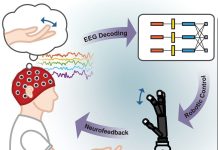
In a new study, researchers have found differences in the brainwaves of autistic teenagers responsible for their visual perception.
This could assist in earlier diagnosis and help inform how support is given to young people with Autism.
The research was conducted by a team at Aston University in the UK.
The team focused on sensory areas of the brain because many people with autism report issues with processing incoming sensory information. They often suffer from hypersensitivity. This means that bright lights, loud sounds or crowded situations can be overwhelming.
They found that different patterns of brain wave activity were triggered in teenagers diagnosed with autism compared to teenagers without autism when performing the same simple visual task.
The research team used Magnetoencephalography (MEG) to look at brain activity within the visual system of 18 teenagers with a diagnosis of autism and 18 teenagers without the diagnosis (aged between 14-20 years), specifically measuring brainwave activity in the visual cortex.
MEG is an imaging technique that measures the small magnetic fields produced by neuronal activity in the brain.
It was found that so-called “alpha” brain waves were less connected from a higher level to lower-level brain regions in the autistic visual system.
In addition, brainwaves across a broader range of frequencies (gamma range) were ‘dysregulated’ in the autistic group, meaning they were not organized as efficiently over time and in synchrony with alpha waves.
The results suggest that even during very basic sensory processing, there are differences in the pattern of brain waves between autistic individuals and their peers who do not have autism.
This is important, given that sensory symptoms were recently added to the condition’s diagnostic criteria.
The results might also explain why over 90% of autistic individuals report atypical sensory responses to visual stimuli.
These experiences are often described in terms of hyper-sensitivities, with more pronounced responses to certain stimuli which result in overwhelming and unpleasant sensations.
The findings of this study could in the future allow for an alternative approach to early diagnosis of autism, offering a new perspective on the current understanding of how circuitry in the brain of an individual with autism.
One author of the study is Robert Seymour, Aston Neuroscience Institute, Aston University.
The study is published in the journal Brain.
Copyright © 2019 Knowridge Science Report. All rights reserved.



